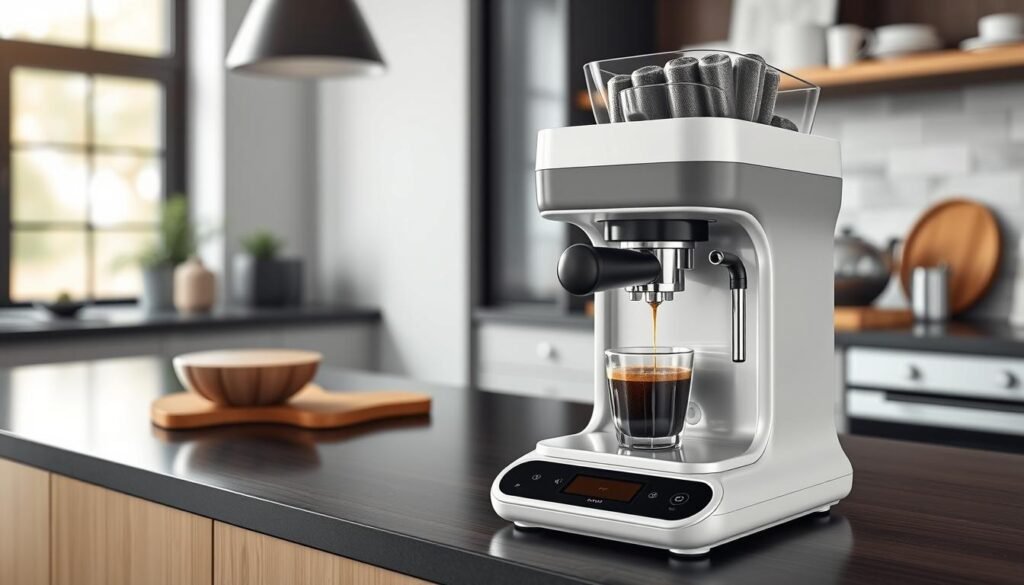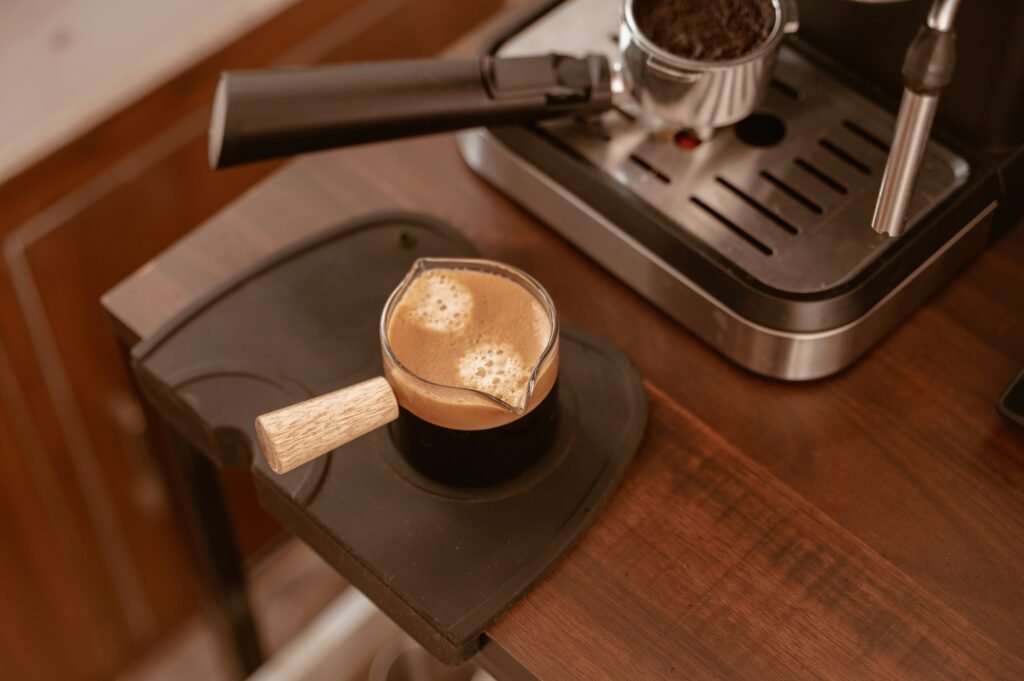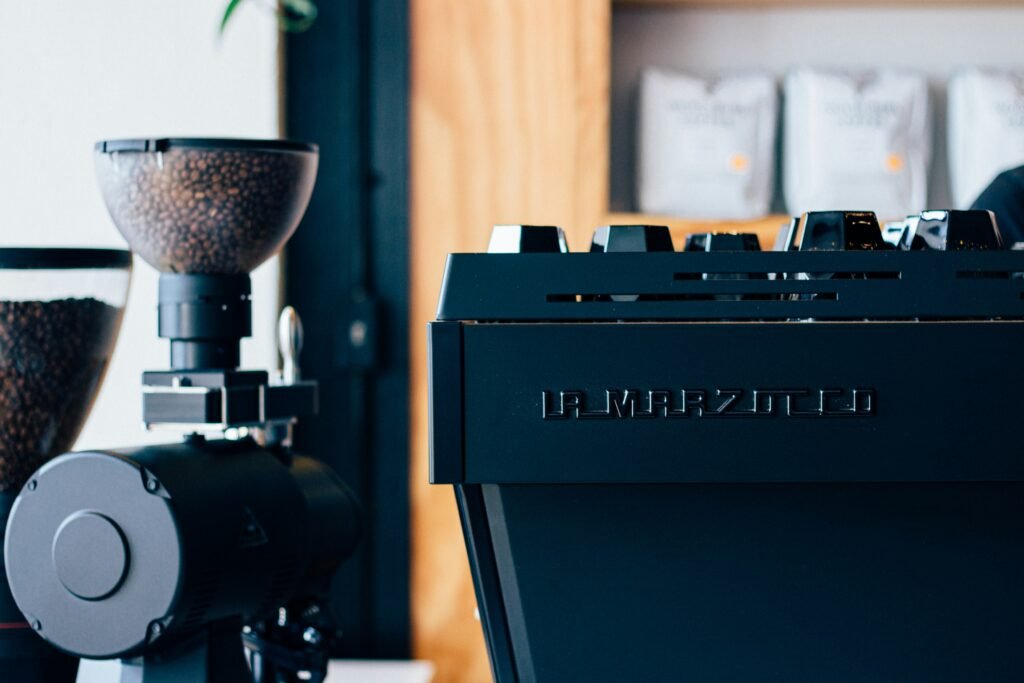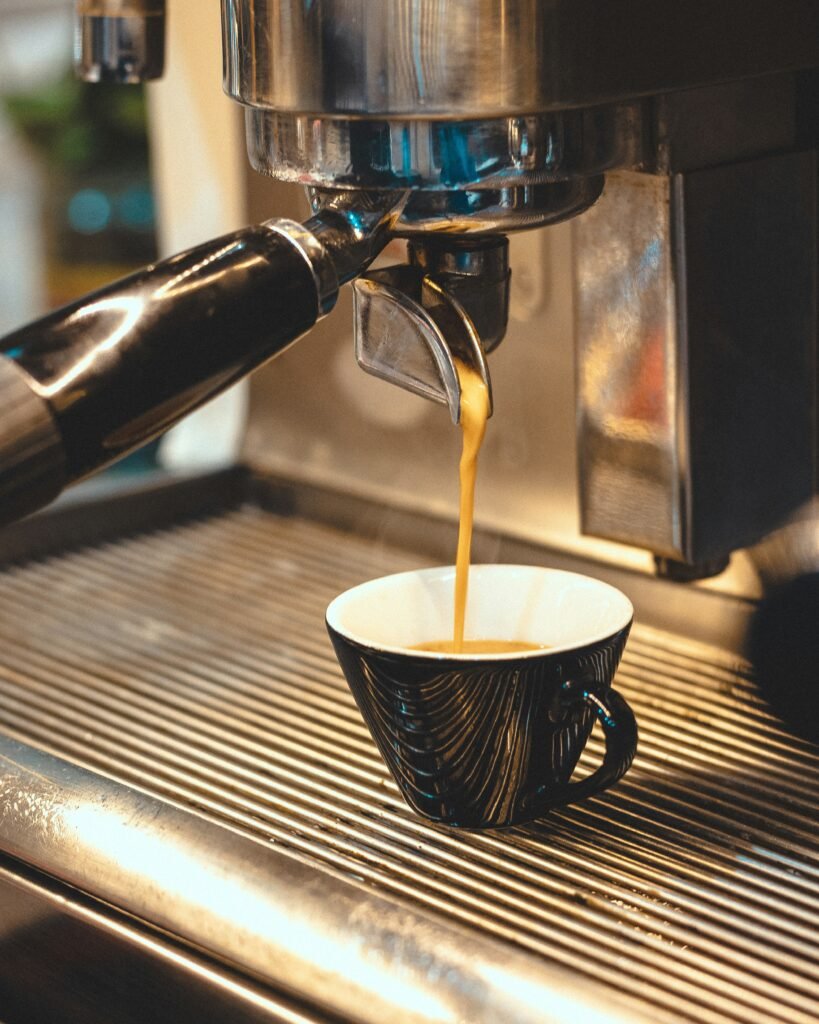Are you tired of mediocre coffee at home? Do you dream of pulling the perfect shot of espresso like a professional?
We’re here to help. With the Breville Barista Express Guide, mastering your machine and brewing café-quality drinks at home is within reach. Pulling a shot of espresso is akin to conducting an orchestra – it requires precision and harmony among different elements.
Understanding the fundamentals of espresso extraction is crucial for elevating your home coffee experience. From selecting the right beans to troubleshooting common issues, our comprehensive guide walks you through each step with expert barista pro tips.
Key Takeaways
- Master the art of espresso extraction for better coffee.
- Learn how to select the right coffee beans for your machine.
- Troubleshoot common issues that affect your coffee quality.
- Elevate your home coffee experience with professional techniques.
- Improve your overall coffee brewing skills with our guide.
The Foundation of Great Coffee: Selecting Quality Beans
Selecting the right coffee beans is crucial for any coffee enthusiast looking to elevate their espresso game. The quality of your coffee beans directly impacts the flavor and aroma of your espresso.

Why Fresh Beans Matter
Freshness is a critical factor when it comes to coffee beans. Stale beans can lead to a disappointing espresso experience, lacking the vibrant flavors and aromas that fresh beans provide. We highly recommend purchasing beans from a local roaster or coffee shop where you can get expert advice on the best beans for your taste preferences.
When buying from a local roaster, you can ask the barista for recommendations based on your flavor preferences. For instance, if you enjoy notes of caramel, chocolate, and nuts, or if you prefer fruity, floral, and citrusy flavors, they can guide you to the perfect beans.
Finding the Right Roast for Your Taste
Understanding your personal taste preferences is key to selecting the right coffee beans for your espresso. We’ve found that medium to medium-dark roasts typically work best for espresso machines, offering balanced flavors without excessive bitterness.
- Single-origin beans often showcase unique flavor characteristics.
- Blends are specifically designed to create balanced espresso with consistent crema.
- Many roasters offer sample sizes, perfect for experimenting with different varieties before committing to a larger purchase.
- Pay attention to the processing method (washed, natural, honey) as it significantly affects the flavor profile of your coffee beans.
By considering these factors and experimenting with different roasts and beans, you can find the perfect match for your espresso preferences.
Essential Barista Pro Tips for Perfect Extraction
Achieving the perfect espresso shot is an art that requires precision, patience, and a deep understanding of the extraction process. To help you master this art, we’ll share our expertise on the essential factors that contribute to a flawless espresso.
Understanding the Extraction Process
The extraction process is the foundation of a great espresso. It involves the careful balance of water temperature, coffee-to-water ratio, and brewing time to coax out the optimal flavors from your coffee beans. A well-extracted espresso shot should have a slow and steady flow of coffee with a thick, golden crema on top. Watch the extraction process closely, as the stream should start as a slow drip and gradually increase to a steady yet still slow flow.
The Importance of Consistency
Consistency is key when it comes to espresso extraction. By maintaining consistent brewing parameters, you’ll be able to reproduce high-quality shots time and time again. This involves being mindful of factors such as grind size, tamping, and brewing time to ensure that every shot meets your standards.
Recognizing Good vs. Bad Extraction
Learning to recognize the visual and taste indicators of proper extraction is a fundamental barista skill. A well-extracted espresso should flow like warm honey, starting with slow drops that develop into a steady stream with a rich, tiger-striped pattern. The color progression during extraction tells a story – it should transition from dark brown to caramel, eventually becoming blonde (but stop before it gets too pale). On the other hand, under-extracted espresso typically tastes sour and lacks sweetness, while over-extracted espresso presents as intensely bitter.
| Extraction Characteristics | Good Extraction | Bad Extraction |
|---|---|---|
| Flow Rate | Slow and steady | Too fast or too slow |
| Crema | Thick and golden | Thin or absent |
| Taste | Balanced flavor | Sour or bitter |
Mastering the Art of Dosing and Measurement

To elevate your coffee game, mastering the art of dosing and measurement is crucial for consistent flavor and quality. The right amount of coffee, measured in grams, directly impacts the extraction process and ultimately the taste of your espresso.
Why Precise Measurements Matter
Precise measurements are vital because they ensure consistency in every shot. Using the correct dose, measured in grams, allows for optimal extraction. For instance, we aim for 9 grams of beans for a single shot and 18 grams for a double shot, resulting in 18 grams and 40 grams of espresso, respectively, with an extraction time of 30 seconds.
Recommended Tools for Accurate Dosing
To achieve accurate dosing, a reliable coffee scale is indispensable. This tool allows baristas to measure the exact amount of coffee needed. When selecting a scale, look for one that is precise, easy to use, and durable.
Dosing Techniques for Different Coffee Drinks
Different coffee drinks require specific dosing approaches. For traditional Italian-style espresso, 14-16 grams are used for a double shot. Modern specialty coffee often employs higher doses, between 18-22 grams. For milk-based drinks like lattes, the dose might be slightly increased to 19-21 grams to ensure the coffee flavor stands out. Ristretto shots use the same dose but less water, concentrating the flavors.
Key dosing techniques include matching the dose to the basket size to avoid improper extraction and machine issues. The amount of coffee used directly affects the flavor profile and strength of the final product.
Dialing In Your Espresso Machine: A Step-by-Step Guide
Dialing in your espresso machine is an art that requires patience and practice. It’s a process that involves adjusting various parameters to achieve the perfect shot of espresso. In this section, we will guide you through the steps to dial in your Breville Barista Express machine.
What “Dialing In” Actually Means
“Dialing in” refers to the process of adjusting the grind settings, dose, and other parameters to achieve the optimal extraction of your espresso shot. It’s about finding the right balance to bring out the best flavors in your coffee. When you dial in your machine, you’re essentially fine-tuning it to work in harmony with the specific coffee beans you’re using.

Parameters to Adjust When Dialing In
When dialing in your Breville Barista Express, there are several parameters you need to adjust. These include the grind setting, dose, and tamp pressure. The grind setting is crucial as it affects the flow rate of the espresso. A finer grind will result in a slower flow rate, while a coarser grind will result in a faster flow rate.
| Parameter | Adjustment | Effect |
|---|---|---|
| Grind Setting | Finer | Slower flow rate |
| Grind Setting | Coarser | Faster flow rate |
| Dose | More coffee | Stronger flavor |
| Dose | Less coffee | Weaker flavor |
Creating a Dialing In Workflow
To dial in your Breville Barista Express efficiently, we recommend establishing a systematic workflow. Start with a baseline setting (medium-fine grind, 18g dose) and pull a shot, noting the extraction time and taste characteristics. Make adjustments one at a time, evaluating the change before making additional adjustments. Keep notes of successful settings for different coffee beans to create a reference library for future brewing sessions.
By following this workflow, you’ll be able to dial in your machine quickly and efficiently, achieving consistent results. Remember, environmental factors like humidity and temperature can affect extraction, so minor adjustments may be needed even with familiar beans.
Grind Size Secrets: Fine-Tuning for Optimal Results

When it comes to brewing coffee, the grind size is a critical factor that can make or break your shot. The Breville Barista Express features an integrated conical burr grinder, allowing you to freshly grind your beans for each brew.
How Grind Size Affects Extraction
The grind size of your coffee beans significantly affects the extraction process. A grind that is too fine can lead to over-extraction and a bitter taste, while a grind that is too coarse can result in under-extraction and a weak flavor.
Adjusting Internal and External Grind Settings
Adjusting the grind size depends on the type of grinder you’re using. For burr grinders, you can adjust the grind size by changing the distance between the burrs. It’s essential to make small adjustments and test the grind regularly to achieve the perfect size.
Grind Size Recommendations for Different Brewing Methods
Different brewing methods require different grind sizes. For espresso machines, a fine grind is recommended, while pour-over methods like V60 or Chemex require a medium-coarse grind. French press brewing works best with a coarse grind, and AeroPress typically performs well with a medium-fine grind.
- For espresso machines, we recommend a fine grind with the texture of granulated sugar or slightly finer.
- Pour-over methods like V60 or Chemex require a medium-coarse grind, similar to sea salt.
- French press brewing works best with a coarse grind resembling breadcrumbs to prevent sediment in your cup.
- AeroPress is versatile but typically performs well with a medium-fine grind, between espresso and pour-over settings.
- Cold brew requires the coarsest grind of all methods, as the extended extraction time compensates for reduced surface area.
Troubleshooting Common Extraction Problems
Troubleshooting is an essential skill for any coffee enthusiast looking to perfect their shot. Extraction problems can be frustrating, but understanding their causes and solutions can significantly improve your coffee experience.
Fixing Under-Extracted Shots
Under-extracted shots are often too sour or weak. To fix this, check your grind size and adjust it to a finer setting if necessary. Ensure your extraction time is within the optimal range (typically around 25-30 seconds for espresso). Also, verify that your tamping is even and that your coffee is freshly roasted.
Solving Over-Extraction Issues
Over-extracted shots can taste bitter or burnt. To address this, try adjusting your grind to a coarser setting to slow down the extraction time. Check that your pressure is set correctly (usually around 9 atmospheres for espresso machines). Regularly cleaning your machine, especially the portafilter and shower screen, can also help prevent over-extraction.
Addressing Inconsistent Results
Inconsistent shots can be due to various factors, including uneven coffee distribution in the portafilter, fluctuating grinder performance, or temperature instability. To achieve consistency, invest in a distribution tool, ensure your grinder is clean and free of oil buildup, and allow your machine to fully heat up before brewing. Maintaining a consistent workflow and regularly cleaning your machine can also help.

By addressing these common extraction problems, you can significantly improve the quality of your coffee shots. Remember, cleanliness and consistency are key. Regular maintenance and attention to detail will help you achieve a perfect shot every time.
Essential Equipment for the Home Barista
To craft exceptional espresso at home, we need to focus on the essential equipment that facilitates this process. As we develop our skills, certain upgrades can significantly improve our espresso quality and workflow.
Must-Have Tools Beyond the Machine
Beyond the espresso machine, several tools are crucial for achieving consistent results. A portafilter is a fundamental component, and using a bottomless (naked) portafilter can provide visual feedback on extraction quality. A dedicated grinder is also essential, offering better consistency and adjustment range compared to built-in grinders.
For instance, a tamping station and a precision tamper like the Crema 2-in-1 Distributor & Tamper can enhance shot-to-shot consistency.
Worthwhile Upgrades for Better Results
As we refine our technique, upgrading certain equipment can lead to noticeable improvements. For Breville Barista Express owners, a precision basket upgrade can improve extraction consistency. Additionally, a grinder upgrade can offer more precise control over grind size, crucial for optimal extraction.
Other worthwhile upgrades include a portafilter upgrade for better distribution and a temperature-controlled milk pitcher for consistent latte art results.
Conclusion: Embracing Your Coffee Journey
As you continue on your coffee journey, remember that the pursuit of perfection is part of the fun. Mastering espresso is a rewarding experience that allows you to explore various flavors and techniques. We hope our barista pro tips have helped you achieve more consistent, delicious espresso at home.
Perfecting your espresso technique is a journey, not a destination. Don’t be discouraged by initial challenges; each “failed” shot teaches you something valuable. Experiment with different beans and techniques to discover what you enjoy. Keep notes on your coffee experiences to refine your skills.
Most importantly, enjoy the process. Great coffee is about pleasure and satisfaction. As you develop your palate, you’ll notice more subtle flavors in your espresso and gain confidence in adjusting parameters to highlight specific characteristics, ultimately creating your perfect shot and appreciating the art of espresso.
You might like our other recipes: See Stories!
FAQ
What is the ideal grind size for a double shot of espresso?
The ideal grind size for a double shot is typically fine, but not too fine. We recommend adjusting the grind setting on your grinder to achieve the perfect flow rate, which is around 1-2 ml/sec. For a Breville Barista Express, start with a medium-fine grind setting and adjust as needed.
How many grams of coffee should I use for a double shot?
For a double shot, we recommend using around 14-17 grams of coffee. However, the exact amount may vary depending on the beans, roast level, and your personal taste preferences.
What is the optimal extraction time for an espresso shot?
The optimal extraction time for an espresso shot is between 20-30 seconds. If the shot is extracted too quickly (less than 20 seconds), it may be under-extracted and taste sour. If it’s extracted too slowly (more than 30 seconds), it may be over-extracted and taste bitter.
How do I adjust the grind size on my grinder?
To adjust the grind size, start by making small changes to the grind setting. For most grinders, a coarser grind setting will result in a faster flow rate, while a finer grind setting will result in a slower flow rate. Experiment with different settings to find the optimal grind size for your brewing method.
What is “dialing in” an espresso machine, and why is it important?
“Dialing in” an espresso machine refers to the process of adjusting the grind size, dose, and other parameters to achieve the perfect shot. It’s essential to dial in your machine to ensure consistent results and optimal flavor.
How do I troubleshoot under-extracted or over-extracted shots?
To troubleshoot under-extracted or over-extracted shots, check your grind size, dose, and extraction time. Adjusting these parameters can help you achieve a balanced shot. If you’re still having trouble, try adjusting your tamping technique or cleaning your machine.

















